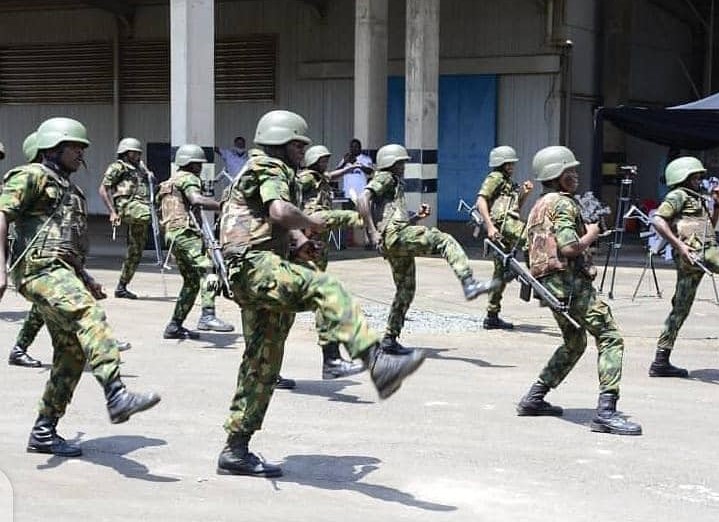A house totally submerged in Bulangu, Jigawa state. 2022
His near future was already planned. Nineteen-year-old Karibu Hassan was looking forward to the harvesting season and had planned how he would put the money realised from the proceeds of the farm he inherited from his parents to good use. He wanted to find a young lady to marry and start a family. Everything was going as planned for Karibu until the rain came.
Karibu lost his only farm to the recent flooding that took over Majiyawar-kaya village in Ringim LGA of Jigawa state. He wondered when and how he would be able to start all over again.
“I have lost everything,” Karibu said, lamenting how all the money he invested in the farm had gone down the drain. “There’s nothing left for me to harvest. Just dry land to clear.”
“I get at least eight sacks of rice from my farm. I inherited the two acres of land from my parents last year. I was building an embarkment when the rain started. When it became too much, I ran for my life,” he said, quietly.
Advertisement

The flooding really dealt a devasting blow. The young farmer, like many others, has tales of woes to share.
For many residents of Jigawa, north-west Nigeria, the rainy seasons bring anxiety and heartache. Between mid-August and September, the state experienced one of its worst floods in years. Though residents are used to the perennial flood, nothing prepared them for the devastation that occurred in the past few months.
Prior to the beginning of the rainy season, relevant agencies responsible for documenting data on climate and weather in the country, like the Nigerian Meteorological Agency (NiMet) and the Nigeria Hydrological Services Agency (NIHSA), warned of heavy rainfall in 18 states, including Jigawa, between the months of August and September.
Advertisement
They also advised states to take preparatory measures to mitigate the flood and actions needed to minimise losses and damages. But despite the alert and preparedness, the torrential rainfall brought unimaginable disaster.
Within a month, Jigawa, an agrarian state, witnessed unprecedented rainfall that swept through LGAs in the state, wreaking havoc from one community to another and leaving disaster in its wake.
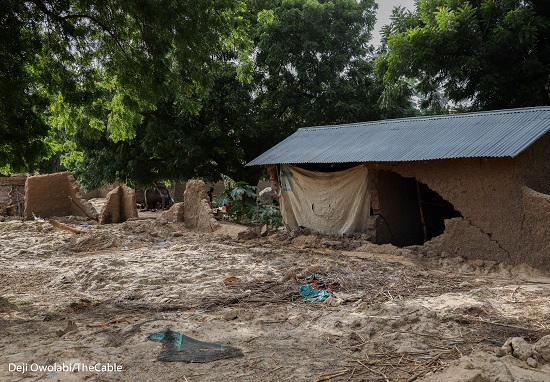
Hundreds of people have died. Infrastructure, livelihood, and food supply have been severely impacted and many people have been displaced. Hectares of farmlands were submerged.
Hassan Yahaya could only escape being swept away by the flood with the cloth on his back. The rain started in the night, leaving residents with little help. The villagers were treated to unrelenting deluge for 14 days.
Advertisement
“These are our farmlands. We could not harvest anything because the crops were all washed away,” Hassan said, pointing at the flooded farmland behind him.
Lamenting how he lost everything he had, Hassan said he was tired of going through the same problem every year. He said before the rain started, the villagers spent 14 days building a sand embankment to protect the farmlands and crops.
According to Hassan, the villagers divided themselves into two; one group focused on erecting an embankment around farmlands while the other group erected another to protect their homes, but the strength of the flood overpowered the structures outside and within the village.
“We have spent fourteen days homeless. We were outdoors, busy constructing these embarkments but on the fourteenth day, the water overpowered us around 11:00 pm,” he said.
Advertisement
“The water came from different angles. While we were trying to stop the flood from penetrating our community cemetery because new corpses were buried there recently, we left our youth here to keep on constructing the embankment for the protection of our houses. We thought we could control it when we divided ourselves, but at last, we failed to do so.
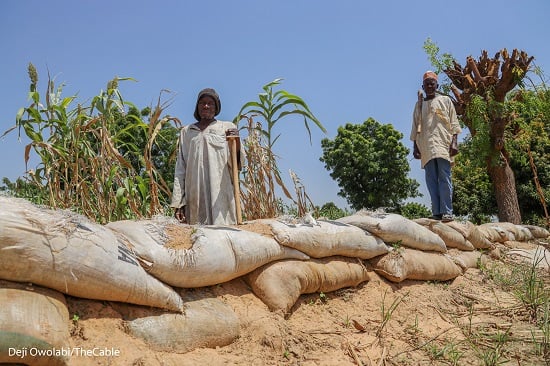
“This shirt I’m wearing has been the one on me since the disaster occurred. For over ten years, we have been at risk of flood and have been living in fear. We urge the government to help and relocate us to a better place because we have no means to protect this land from such kind of flood.
Advertisement
“We struggled enough to build our mud houses which were all brought down. We lose all our farm products annually.”
“WE DON’T HAVE FOOD TO EAT”
Advertisement
Hassan said some of the victims affected by the flood have resorted to selling wood that was once used to roof their houses to pay their bills.
“We don’t have food to eat. We have lost our source of income. We are just sitting under the shade of trees, doing nothing,” he said.
Advertisement

To reduce the burden and find a means of survival, the men took their wives and children to a resettlement camp (a primary school) while they stayed back to scrounge up a living
“No single room in our houses was saved by the flood. Nothing was left in our stores and the farmlands,” he said.

Abdullahi Sabo, district head of Majiyawar-Kaya, said more than 100 houses were washed away by the flood despite the walls erected around the village.
“We lost animals and our food. Since we have been experiencing this issue, we have not received any assistance from the government but some non-governmental organisations and some well-to-do individuals usually come to help us,” Sabo said.
“Everything we lost during the disaster can be estimated to be N100 million, which includes houses, properties and farmlands.”
FARMERS KEEP COUNTING THEIR LOSSES
In Bulangu, this reporter was accompanied by Abdullahi Garba, the representative of the district head of Kaigamari, and three other farmers to the farmlands. The long stretch of land had already turned into a river. Save for electrical poles erected on the farms, one would have thought it was a river.

Garba, a retired teacher and a father of 15 children, said it was the first time the village would witness such kind of flood.
“In fact, we have never seen this kind of flood before. It covered all our farmlands,” he said, shaking his head. “This place was not a river but as a result of the flood, it seems like a permanent river. It is our farmlands. We can’t even estimate the number of farms that we lost during this incident because my ward comprises Busuri, Malamawa, Gandu, Garin Sama, Boyi, and Kaigamari. About 700 farms were washed away in Kaigamari alone,” Garba said.
“In this farm, I planted millet, guinea corn, sesame and beans. It is about six hectares of land in size and it was washed away. In normal circumstances, by the end of the season, I harvest millet and guinea corn of not less than 40 bags; beans of about five to six bags.
“As a retired teacher. I have no other means of livelihood. I am not benefiting from any governmental loan. I inherited the farmland from my parents.”
The story was not different in Hadejia LGA which is one of the worst-hit.
“This is not the first time we will be affected by a flood. Almost six times now and even twice last year. But the flood this year is worse than previous years,” Lamido Kawu, Sarkin Fulani, told TheCable.
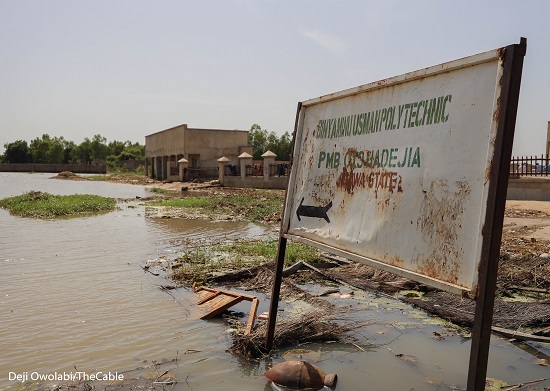
“Immediately the rain started and the water was not drying up, we packed the few things we could and moved down to this camp. We asked the local government authority permission before moving to this school.
“We are scattered around. Some are in the bush. We’re just the lucky ones here. In our community, we farm rice, sesame, millet sorghum, and beans. They have all been destroyed by the flood. Only God knows how much I have lost. My rice farm occupied two hectares of land, millet was planted on three hectares, and sesame, one hectare. Roughly, the rice plantation would be worth N2.5 million.”
Kawu said the measures taken at the start of the rain saved the villagers from losing all. Some of their livestock survived.
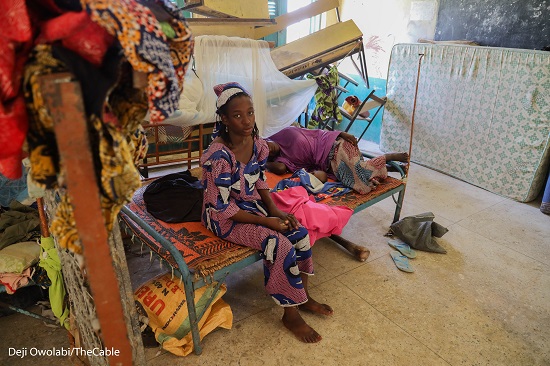
According to the State Emergency Management Agency (SEMA), the state is already overwhelmed. Yusuf Sani, executive director of the agency, said temporary camps in schools and other government buildings were set up to cope with the influx of families ravaged by the flood.
“This incident is particularly sad because it has become perennial. This is causing serious damage to schools, houses and the livelihood of the people,” Sani said.
THE WATER SPILL FROM DAMS
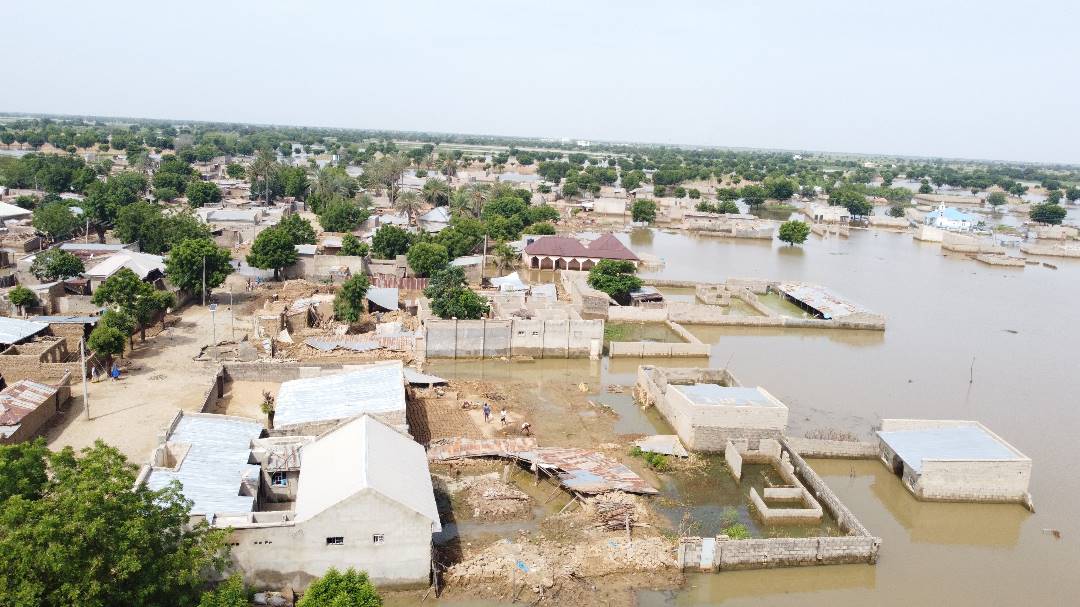
Sani blamed the recent release of excess water from dams as part of the causes of the devastating flood. He said the overflow of water from Tiga and Challawa dams in Kano state worsened the flood.
“These two dams are the main supplier of water crossing River Hadejia. The water flowed to many villages and LGAs. These dams are being silted, so they can’t hold plenty capacity of water. Once the dams spill their content, the water flows to the river,” he said.
“There River Hadejia crosses about 12 LGAs and almost every year, we encounter flood in almost all of them. These LGAs include Ringim, Jahun, Taura, Kafin Hausa, Auyo, Malam Midori, ‘Miga’, Hadejia, Kiri Kasama, and Guri. We have about 237 villages seriously affected by the flood. Some of them are completely destroyed with their farmlands.
“We lost about 127 people. IDPs in different camps are getting to about 57,000 and we are responsible for their feeding. Day in and day out, we supply them with food and other items needed.”
Sani added that several roads and 22 bridges have been washed away by the flood, making the state capital inaccessible to many LGAs.
He, however, noted that the agency has provided relief items to all affected LGAs “including canoes to flooded areas”.
“WE’RE TRYING OUR BEST”

When contacted, Hamza Mohammed, special assistant to the Jigawa governor on community development and social inclusion, told TheCable that the state government took precautions and sought ways to reduce the impact of flooding but the torrential rainfall brought an unimaginable disaster.
He said a committee was set up with the mandate to analyse the weather prediction and develop solutions that will mitigate flooding.
“So the committee went out to supervise the critical areas from the entry point of the state, that is the Dabi town in Ringim LGA. We uncovered some factors that contribute to flooding in the state which included infestation and blocking of waterways by aquatic weeds; the diversion along midstream,” Mohammed said.
“So the government directed us to work assiduously to come up with solutions to minimise flooding when it happens.

“Since March, we have been working with a combined team of experts from the ministry of works, environment, water resources, and agriculture. Making embankments around critical areas to address diversion. Alignments were also made to expand the river; standard dikes were also built in order to protect these settlements from the flood.
“Downstream, the government also mobilised communities and supported them with necessary local materials including machines for dredging for the movement of aquatic weeds along waterways to allow the free flow of water downstream. The commitment of the state to addressing floods before they occurred helped the state to reduce the menace. It could have been worse than what we have today.”
Corroborating SEMA’s findings, Mohammed explained that owing to the heavy rainfall in the country, excess water from dams upstream spilled over into the state. The government said the holding capacity of Tiga and Challawa dams in Kano state has been reduced.
“The holding capacity of the integrity of the dams has been reduced by about 6 billion cubic metres and the excess drain into Jigawa. The volume and pressure of the water caused the flooding in the state,” Mohamed said.
Mohammed stated that more than 150 people have lost their lives in the state as a result of flooding. About 72,589 have become IDPs and over 176,822 people have been displaced so far.
“Over 370,000 hectares of land have been submerged; more than 650 hectares of land are cultivated annually during the wet season for rice but out of this, over 370 have been submerged and washed away by the flood,” he said.
Mohammed noted that the state is still collating information about affected farmers and farmlands to ascertain the extent of damage caused by the spillover from the dams.
FOOD INSECURITY
Jigawa is known as one of the largest producers of sesame in Nigeria. Sesame is one of the top major agricultural products exported out of the country for foreign exchange. Rice, wheat, and other farm produce are also cultivated in the state.
The state, at the moment, faces the risk of moderate food insecurity, according to authorities.
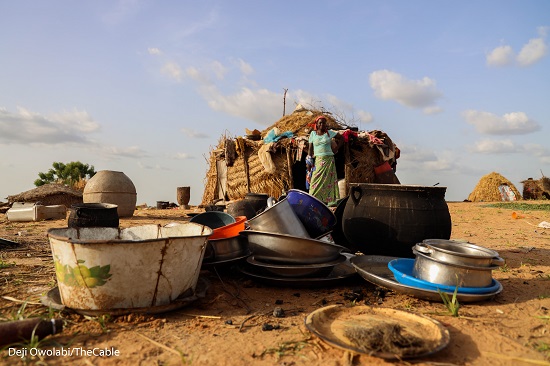
Mohammed told TheCable that the flood “has caused serious damage to the economy of the state” and hindered access to other LGAs, farms, and local markets.
“Part of the impact of the flood is that it has affected our food security. Because the economic backbone of Jigawa is agriculture. That is our major investment. The economy has been set back,” he said.
Before the flood, farmers were already battling with the price of agricultural inputs like fertilizer, access to loans, and the cost of transportation, among other issues. Coupled with the flooding disaster, it has become difficult for farm produce harvested before the flood to be moved from northern Nigeria to other parts of the country.
For a farmer like Lamido Kawu who had laboured during the planting season and now has nothing to show for his efforts, the flooding might linger in his memory for a few years. He was filled with hope that by the end of October, he would have harvested tonnes of millet which he would have sold at the market. But in just a few hours, everything was washed away.

“For instance, we would have started harvesting some crops now, like millet which is due for harvest this month. The rice and sesame seeds will take up to a month or two, the same for beans and sorghum, before they become ready to be harvested. They have all been destroyed by the flood,” Kawu lamented. “The few livestock left is what we will rely on for money.”
Mohammed said to insure the state against food insecurity, farmers would be taught adaptive measures.
“The government directed the ministry of agriculture to go around and come up with a comprehensive report and details of the farmers that have been affected. The government will complement and support them with different types of early variety crops so that they will have food to sustain their livelihood,” he said.
“The farmers will also be supported with grants so that they can bounce back from the losses. This grant is not new but routine support from the government every year.”
CHILDREN NO LONGER GOING TO SCHOOL
Farmers are not the only ones bearing the brunt of the flood. The education of pupils is also being adversely affected.
Many of the schools have been submerged in the LGAs. Schools in 22 out of 27 LGAs are affected, according to authorities. The academic calendar had to be altered to accommodate the impact of the flood on the students. Pupils were supposed to resume the new session on September 20, but an extra two weeks was added.
For pupils in Hadejia LGA, parents struck an agreement with teachers to come and teach their wards at the IDP camps. “Even if it’s under trees, they’ll teach the children here,” Kawu said.
In Ringim, the students try not to miss out by going to evening classes in a neighbouring village.
“We’ve been trying to help our kids with their schooling. They go to the school in another village; it’s not far, not up to a kilometre. The school runs two shifts. Their own kids attend classes in the morning while ours go there in the evening,” Hassan told TheCable.

To lessen the effect on education, Mohammed said the government plans to set up mobile classes across the state to facilitate learning.
“The government has planned to support the pupils with e-learning facilities. The ministry of education, science, and technology in Jigawa state has a lot of tablets to support the students with the e-learning process,” Mohammed said.
PREVENTING FLOOD: EXPERTS SPEAK
Weighing in, Adeniyi Sanyaolu, an environmental consultant and a senior lecturer at the University of Uyo, said one of the reasons rainfall is becoming more of a problem in Nigeria is because of widespread deforestation.
He explained that the forest and vegetation serve as a buffer and natural sink for excess water but tampering with them brings negative impacts.
“In the past, we had vegetation which served as a natural sink for excess water; but now, most of them acting as a cover is gone,” Sanyaolu said.
“Forest controls water cycle. With deforestation, the rain becomes less predictable and the intensity is more. That gives room for flash floods. The vegetation would have acted as a buffer, and the soil too would have sunk in this excess rain but they are no longer there.
“We can’t also ignore the contribution of climate change to this. There is global warming. Tackling the problem of flooding must be a holistic approach. Re-afforestation should be encouraged. We will have less erratic rainfall. Soil conservation measures to reduce soil erosion to protect natural habitats.
“Rapid urbanisation is also making infrastructural facilities overstretched. The roads and drainages are not enough to cope with the population pressure.
“The land use policy involving flood plains, river basins, all these places have been affected by unplanned development. People now build in flood plains. The governments need to take more proactive measures. Building constructions in flood plains should be discouraged outrightly.”
To further control the perennial problem of flooding, Sanyaolu said drainages should be expanded and the government needs to be intentional about it.
Add a comment

